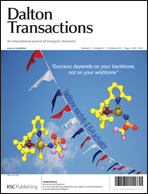Terpyridine platinum(ii) complexes containing triazine di- or tri-thiolate bridges: structures, luminescence, electrochemistry, and aggregation†
Abstract
Dinuclear complexes [{Pt(trpy)}2(L)](PF6)2 (trpy = 2,2′:6′,2′′-terpyridine, L = 2-octylthio-1,3,5-triazine-4,6-dithiolate ion (1), L = 2-octadecylthio-1,3,5-triazine-4,6-dithiolate ion (2), L = 2-di-n-butylamino-1,3,5-triazine-4,6-dithiolate ion (3)) and a trinuclear complex [{Pt(trpy)}3(L)](PF6)3 (L = 1,3,5-triazine-2,4,6-trithiolate ion (4)) have been synthesized and characterized. The single crystal X-ray analysis revealed that the two {Pt(trpy)}2+ fragments in 1 and 3 adopt a syn-configuration. The Pt⋯Pt distances are around 4.3 Å, suggesting no intramolecular Pt⋯Pt interactions. Complexes 1–4 in acetonitrile show broad absorption bands at around 470 nm, assigned to mainly the ligand-to-ligand charge transfer (1LLCT) from triazine thiolates to trpy based on the comparison to the related complexes and the density functional theory (DFT) calculations. The red luminescence of 1–4 in acetonitrile is attributable to emission predominantly from 3LLCT. Cyclic voltammograms of 1–3 exhibit four redox couples from −2.0 V to 0 V vs. Ag/AgCl. The two consecutive processes at around −0.70 V are assigned to the sequential reduction of two trpy ligands. This assignment was further supported by the observation of the anion radical of trpy in spectroelectrochemical experiments. The splitting of the redox potentials of two trpy ligands evidences the moderate electronic coupling interactions mediated by the triazine dithiolate bridges. Complex 2 formed a transparent red gel in CH3CN, whereas 4 produced a gel-like solid in the mixtures of CH3CN and other solvents. The interactions dominating the aggregative behaviours have been discussed based on the results of electronic absorption and emission spectroscopy.


 Please wait while we load your content...
Please wait while we load your content...